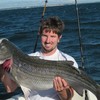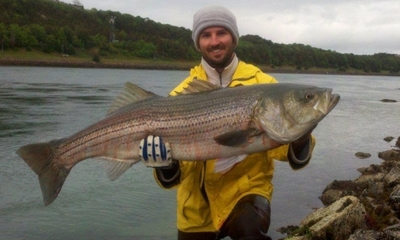The Cape Cod Canal is one of the most challenging and rewarding places along the entire East Coast of the United States to fish for striped bass. Few locations on earth offer the shore bound angler a better chance at hooking a bass in the 40 pound range.
The man-made land cut has produced spectacular fishing the past few seasons. The spring run of big striped bass has been just as impressive, if not more impressive than the famed autumn migration.
If this spring is anything like the spring of 2010, impressive schools of trophy size striped bass should enter the canal over the upcoming weeks. For the Barnstable angler, the 25 minute drive to the "Big Ditch," as it is referred to by canal regulars, could very well produce some of the biggest bass of the season.
Timing is Everything
The canal will support a population of striped bass from May through October. But to really cash in on great canal fishing, a fisherman needs to be at the canal when a large biomass of striped bass moves through the land cut.
Unfortunately, it is inherently difficult to predict when this will occur. However it can help to stay up to date on Vineyard Sound and Buzzards Bay fishing reports. Stories of large schools of surface feeding striped bass in Buzzards Bay will often trickle in a few days to a week prior to a canal blitz.
These fish are on a northward migration pattern that often brings them directly through the Cape Cod Canal as opposed to the longer trip around the arm of the Cape. At this time of the year the canal is filled with herring, mackerel, whiting and a plethora of other prey items. The canal naturally sets the stage for a world class fishing opportunity.
Top-notch fishing seems to occur in phases as biomasses of striped bass migrate through the land cut northward into Cape Cod Bay. Often time's spectacular fishing will occur for a day or two as the school migrates through. A phase of slower fishing ensues, until the next large push of bass happens a week or so later.
I remember a Thursday morning during 2010 when anyone who could cast a plug more than 30 feet was into big fish. It did not take long for word to get out, and by Saturday morning the canal was packed with anglers. However the biomass of bass had quickly exited the canal late Thursday/early Friday. I did not see a single fish taken that Saturday morning.
The Top Water Bite
The top water action at the canal can be downright nutty during the spring. Simply put, there are not many places in our area where a shore bound fisherman can cast surface plugs to 30 pound bass.
With that said, not every angler will cash in on the fantastic top water action this spring at the canal. Long casts of more than 200 feet are often needed to reach breaking fish.
Loading the tail end of an aerodynamic surface plug with weight can substantially increase casting distance without killing the action of the plug. Using ultra thin braided line and the best rods and reels money can buy will certainly help. However nothing beats a sound casting technique.
Bass are relatively easy to fool with top water plugs when the fish are honed in on larger prey items such as tinker mackerel. It can be a completely different story if the fish are focused on smaller prey such as juvenile whiting.
On numerous occasions last year, canal fishermen witnessed smaller bass feeding aggressively on small prey items early in the morning. All efforts to catch these fish went unrewarded as it was nearly impossible to reach these breaking bass with a plug that matched the size of the bait these smaller stripers were feeding on.
However as the morning and tide progressed, the smaller prey items were replaced by mackerel. Larger bass replaced the schoolies, and everyone began hooking up. Things change quickly this time of the year at the canal.
Working the Bottom
Nothing beats watching a big bass crush a popper, however phenomenal top water action is still the exception and not the rule. Anglers who learn how to effectively work the bottom of the canal regularly land large bass when nothing is showing on the surface.
An entire book could be written on how to jig the canal. Being able to locate productive holes and choosing a setup that will allow you to efficiently fish the bottom are two of the more important factors influencing jigging success.
The entire canal is littered with dramatic ledges and drop-offs that disturb the natural flow of current. These areas offer bass reprieve from a cranking current, acting much in the same fashion as a large building blocking a stiff breeze.
These areas look very different at separate stages of the tide. The tell-tale sign of a "hole" or ledge is the disturbance that the hole or ledge creates on the surface of the water. This area of rip water will be a bit farther down current from the actual physical structure responsible for the rip water.
It is possible to locate the exact location of the hole or ledge by counting the number of seconds it takes for your 3 to 6 ounce jig to hit bottom. By fan casting an area, an angler can learn the relative depth of one area compared to another.
Prime jigging areas in the canal will often consist of a leading edge that could be only 30 feet deep, followed immediately by a hole that bottoms out at around 50 or more feet. Finding these areas and placing your offering into the deeper gulley is the key to consistently jigging up cow bass.




